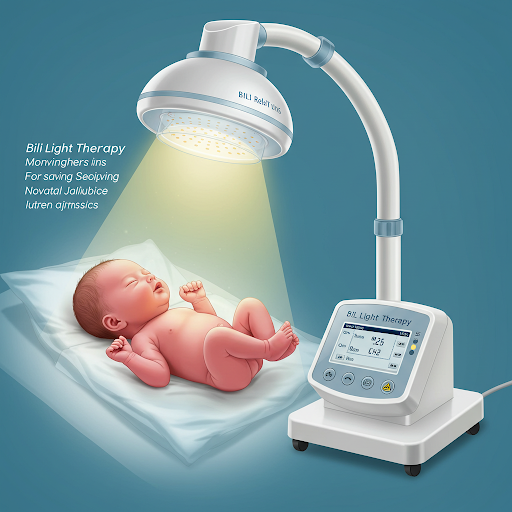Bili Light Therapy: A Lifesaving Solution for Neonatal Jaundice
Neonatal jaundice, a common condition in newborns, occurs due to elevated levels of bilirubin in the blood. If untreated, high bilirubin levels can lead to kernicterus, a severe neurological disorder that causes irreversible brain damage, cerebral palsy, auditory neuropathy, gaze abnormalities, and dental enamel hypoplasia (Maisels & Watchko, 2013). Phototherapy using a bili light is the standard treatment for neonatal jaundice, effectively reducing bilirubin levels and preventing complications.
4/3/20252 min read


How Bili Light Therapy Works
Bili lights use a specific range of blue light (420–470 nm) to convert bilirubin into a water-soluble form that can be excreted through urine and feces (American Academy of Pediatrics, 2022). This process, known as photoisomerization, allows the infant's body to clear excess bilirubin without requiring invasive treatments like blood exchange transfusion.
During phototherapy, the newborn is placed under a bili light, typically in an incubator or a bassinet. Soft protective goggles shield the baby’s eyes from potential damage caused by the intense light exposure. To maximize the skin’s exposure, the baby is usually unclothed except for a diaper and is repositioned regularly (Bhutani & Stark, 2016).
Types of Bili Light Therapy
Conventional Overhead Bili Lights
Traditional bili lights are positioned above the baby, emitting blue light downward. These units are commonly used in hospitals and neonatal intensive care units (NICUs). They provide effective phototherapy but require careful monitoring to ensure proper exposure (Maisels, 2015).
Biliblankets: Home-Based Phototherapy
A biliblanket is a portable phototherapy device consisting of fiber-optic cables that deliver light directly to the baby’s skin. The blanket is wrapped around the infant, allowing treatment to continue while the baby is held or fed. Biliblankets have become a preferred option for home treatment, providing convenience and reducing hospital stays (Ebbesen et al., 2004).
Advantages of Bili Light Therapy
Non-Invasive: No need for medication or injections, reducing risks for newborns.
Effective and Safe: Proven to lower bilirubin levels efficiently without long-term adverse effects.
Home Treatment Options: Biliblankets allow for treatment at home, promoting bonding between the baby and parents while avoiding hospital-related stress.
Potential Side Effects and Considerations
While bili light therapy is generally safe, some infants may experience temporary side effects such as:
Dehydration: Increased fluid loss due to prolonged exposure to light; frequent feeding is encouraged.
Temperature Instability: Babies may lose body heat while unclothed, requiring temperature monitoring.
Bronze Baby Syndrome: A rare condition in which the skin takes on a grayish-brown hue; this typically resolves after phototherapy ends (Kaplan et al., 2011).
When is Phototherapy Necessary?
The need for phototherapy is determined by measuring bilirubin levels in relation to the baby's age and risk factors. The American Academy of Pediatrics (AAP) provides guidelines for when to initiate treatment based on total serum bilirubin levels (AAP, 2022). In severe cases, where phototherapy alone is insufficient, exchange transfusion may be required.
Conclusion
Bili light therapy remains the gold standard for treating neonatal jaundice, preventing severe complications associated with high bilirubin levels. With advancements such as biliblankets, treatment can now be administered both in hospitals and at home, providing greater flexibility for parents while ensuring the best outcomes for newborns.
References
American Academy of Pediatrics (AAP). (2022). "Management of Hyperbilirubinemia in the Newborn Infant." Pediatrics, 150(3).
Bhutani, V. K., & Stark, A. R. (2016). "Jaundice in the Newborn." New England Journal of Medicine, 375(4), 481–490.
Ebbesen, F., Agati, G., Pratesi, R., & Rigato, F. (2004). "Efficacy of Biliblanket in Treating Neonatal Jaundice at Home." Pediatrics, 113(2), 156–160.
Kaplan, M., Hammerman, C., & Maisels, M. J. (2011). "Bronze Baby Syndrome: A Clinically Significant but Rare Condition." Journal of Perinatology, 31(2), 155–159.
Maisels, M. J. (2015). "Phototherapy for Neonatal Jaundice: An Update." Seminars in Perinatology, 39(3), 239–244.
Maisels, M. J., & Watchko, J. F. (2013). "Jaundice in Healthy Newborns: Natural History and Treatment." Pediatrics, 131(4), 1014–1020.
